- Home
- Subscribe
- Magazine
Current Issue
- Table of Contents
- Feature Article
- Subscribe
- X's & O's Vault
- Gridiron Store
- Help
- Contact Us
Add Some Bunch to Your Playbook
© October, 2008
by Steve Heck
Wide Receivers Coach, Kutztown University (PA)
One of the interesting aspects about college and high school football is the wide spectrum of offensive attacks emerging at both levels. Ideas, concepts and offensive systems have trickled down from college football to the high school level thanks to clinics, networking, and publications such as Gridiron Strategies, that cater to coaches at all levels. High school teams are throwing the ball now more than ever. One of the formations that has served us well over the years is the popular “bunch” formation.
In the simplest term, ‘bunch’ means aligning three receivers in close proximity to each other. The bunch formation provides several advantages for the offense. First, it quickly deploys multiple receivers into a given area of the defense. Flooding a zone quickly can cause confusion for the secondary. Second, it creates mismatches if defenses “banjo” coverage and switch assignments. Also, by using compressed formations like bunch, the offense expands the field and thus creates additional space for the defense to cover. Perhaps the most well known advantage of the bunch set is the natural rubs or picks that are created. However, we have discovered that while the rubs are sometimes effective in goal line situations, coaches have gotten very good at minimizing the effectiveness of rubs and picks.
Being a spread offense, based out of multiple one back sets, we have added several bunch concepts to our playbook. One of the most popular bunch plays is the toss (See Diagram 1). In this alignment, our bunch is tighter to the out tackle, allowing the point man in the bunch to block down. We give our receivers simple rules for blocking the toss. Our A receiver, who is on the point of the bunch, blocks down. This may require him to block a defensive end, or an outside linebacker. Our X receiver blocks the #2 perimeter defender. Usually this is a safety or a linebacker adjusted out. Our Z receiver blocks the #1 perimeter defender. This is usually a cornerback, and this is usually a kick out block, with the back cutting it inside the block. Teams give us a variety of looks against the bunch, so these simple rules allow us to handle multiple looks. We also pull the play side guard to pick up any force player running the alley or an overhang defender that appears late.
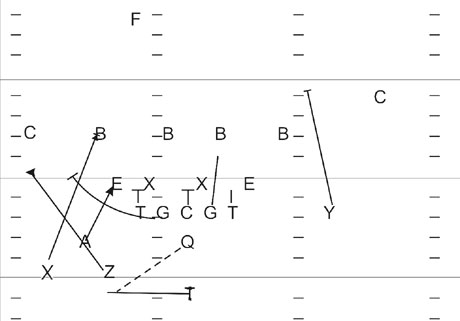
|
After some initial success with the toss, teams began to fly up hard on the perimeter to defend the play, forcing us to find an answer with play action. The play action combination off of the toss fake originated from Coach Andrew Coverdale. We simply used one of his combinations and added the play action element, calling the play “Temple” (See Diagram 2).
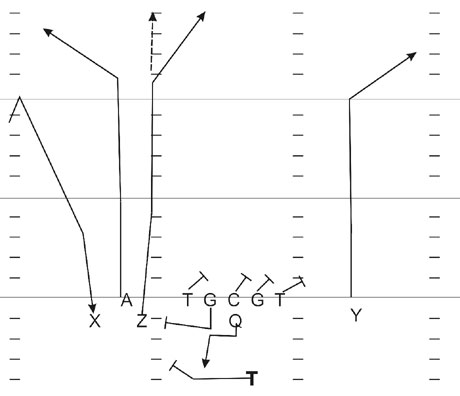
|
Everything looks the same for the offensive line. We pull the guard to seal the play side edge. The rest of the line steps opposite the toss fake blocking back. Our tailback fakes the toss and comes off the fake late to help on the edge. The quarterback gives a hard toss fake, incorporating head and eyes to sell the fake. Following the toss fake, the QB gets back into a quick three step drop, which times up with the depth of the routes.
The receivers use “play-action tempo” for the first few steps of their release to help sell run. It is important to coach low pad level on the releases of all three receivers. Our X receiver runs a fin route at 10 yards. The fin is simply a lazy comeback. We coach the X to get width immediately upon his release. We want to widen the cornerback with the fin route. The A receiver runs a 12 yard sail route. He releases with low pad level and play action tempo and bursts into his sail route, flattening his break vs. a cover 2 safety. Our Z receiver runs an inside seam route. Versus 1 high safety he must cross the safety's face with a post route and pull him to the middle. Versus a middle open look, he runs a deep seam.
The two routes that pop open are the sail and the seam. The fin route successfully widens the corner and provides a hole to hit the sail. If the safety jumps the sail the seam/post is the throw. We coach the QB to work from the middle of the field out. He looks at the seam/post first, progresses to the sail and ends with the fin. Rarely do we get to the fin. Our backside route by Y varies depending on the game plan.
To disguise “Temple” we have used multiple formations and motion to keep the defense off balance. Diagrams 3 and 4 illustrate how we use compressed 2x2 formations and motions to get into our bunch set. The use of motions forces the defense to think and react and possibly check to another coverage. It also creates some confusion for young defensive backs who may not be good at communicating. The routes do not change, but to the defense, it is a different look.
While “Temple” has proved to be a valuable tool in getting the ball down the field, our “Ohio” combination is a reliable, move the chains as a utility play. Unlike the toss and “Temple,” the bunch is moved a bit wider for “Ohio” (See Diagram 5). Our Z receiver is 5 yards from the offensive tackle.
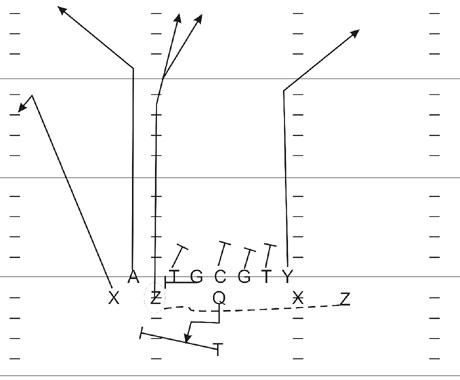
|
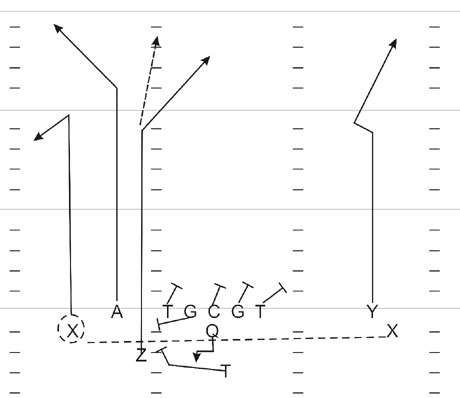
|
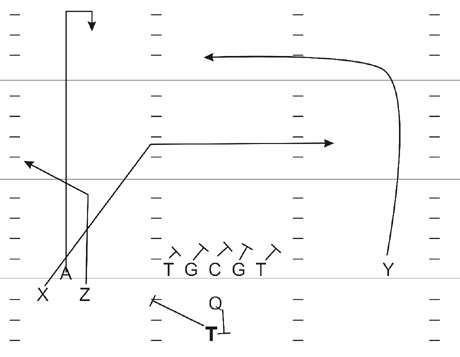
|
One often overlooked aspect of coaching the bunch scheme is the release. It is important to coach the receivers on release priorities. The A receiver and the X receiver release at the same time. The Z is the last receiver to release. The A runs a 10-yard curl finding a window and settling down. The X runs a 6-yard shallow cross and works underneath the linebackers. The shallow route by X draws a lot of attention from inside linebackers and prevents them from expanding into the curl window. Versus an edge blitz, the X looks right away as he releases underneath. The Z, releasing last, runs a 4-yard speed out. The backside receiver, who is our Y, works a deep cross at 10-12 yards.
“Ohio” is a 5 step drop for the quarterback, who must get a pre-snap coverage read and locate blitzers. “Ohio” is a utility play for us because it can attack man and zone schemes and provides a quick outlet vs. pressure. Against zone coverage we have a curl/flat concept and vs. man coverage we have crossing routes at varying depths. The only drawback to this combination is the lack of a vertical threat. If you need a deep shot, the speed out by Z can convert to a wheel. Also, with athletic receivers running crossing routes, the run after catch can quickly turn into an explosive play.
If you are looking for diversity in your offense, explore some of the possibilities that the bunch formation provides. For an inexperienced quarterback, the bunch set simplifies things and puts everything right in front of him. Also, instead of having to make complex reads, a young QB can simply let the play unfold and get the ball to the receiver that comes open. Like everything else, it is important to remember that balance is important. You must create ways to both pass and run out of the bunch.
Steve Heck is the Wide Receivers Coach at Kutztown University. You can reach him at SteveHeck@GridironStrategies.com.
WHAT IF?
Q1. What if the defense was in a 3-5-3 rather than a 4-3 or 4-4 defense? Do you need to make any adjustments in your Bunch Toss play?
Versus the 3-5-3 we would make some modifications to the blocking scheme on the bunch toss. The point man on the bunch set would still block down but now he will look for the Sam LB. The number 1 WR in the bunch set will block down on the rover linebacker who will likely try to jam the point man in the bunch. The number 3 WR still releases for the corner and we pull the play side guard around for the Mike LB.
Q2. What if the CBs and a safety are all playing press coverage on your trips set? Does that affect their routes for pass plays?
Teams are usually reluctant to play press coverage vs. bunch because it increases the likelihood for rubs to occur. However, if teams do press, rarely will all three defenders be on the same level. Some teams will ‘Banjo’ the coverage to avoid a collision. The most important key we have discovered is coaching up the point man in the bunch to execute a clean release. We have a preferred order of release in our bunch pass game and it is important to practice the timing of these releases vs. various coverages.
Q3. What if you face an all-out blitz while running ‘Ohio’? What adjustments/reads and blocking assignments are adjusted?
While ‘Ohio’ has some natural blitz protection built into the combination, we should strive to keep all three routes on the move. The point WR would adjust to a Seam/Open concept that gives him the potential to push his route up the field finding some holes between the hashes at around 12-15 yards. We also work on hitting the number 1 receiver working inside right away on a shallow route. It is important to remind the quarterback to keep it simple and see if he has a clearer picture on the back side.
Sign Up for the Play of the Week Newsletter


Subscribe
Login
Renew
Change Address
Customer service